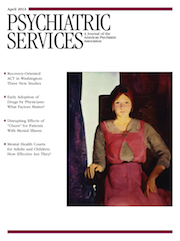Patient Acceptance of and Initiation and Engagement in Telepsychotherapy in Primary Care
Abstract
Objective
The study examined factors associated with the utilization of psychotherapy offered in primary care via videoconferencing (telepsychotherapy).
Methods
Primary care patients with depression (N=179) recruited from five Federally Qualified Health Centers were randomly assigned to telemedicine-based collaborative care and offered free telepsychotherapy. Independent variables included measures of access to and need for treatment. Logistic regression identified variables associated with acceptability of and initiation and engagement in telepsychotherapy.
Results
To 76% of patients the idea of participating in psychotherapy was acceptable. Thirty-eight percent scheduled a telepsychotherapy session, 17% attended a session, and 8% engaged in treatment (attended at least eight sessions). Because the intervention was designed to minimize barriers, access was not a significant predictor of utilization. However, use of telepsychotherapy was associated with measures of perceived need.
Conclusions
Even when psychotherapy was delivered in a primary care setting via videoconferencing to minimize barriers, few patients initiated or engaged in telepsychotherapy.



